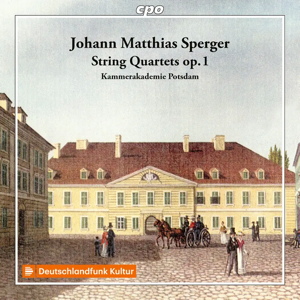
Johann Matthias Sperger (1750-1812)
String Quartet No. 1 in F (1782?)
String Quartet No. 2 in A (1782?)
String Quartet No. 3 in C (1782?)
Members of the Kammerakademie Potsdam
rec. 2021, Andreaskirche Berlin-Wannsee, Berlin, Germany
cpo 555 470-2 [55]
These quartets prove Johann Matthias Sperger to have been a fine composer, though, like most of his Classical contemporaries, overshadowed by Mozart and the pioneering Haydn. All three scores presented here follow a somewhat backward-looking, three-movement format akin to Baroque sonatas: an opening sonata movement, a rather brief slow movement, and a concluding rondo. On the other hand, the sonorities comprise four truly independent parts – the viola is not chugging along up the octave from the cello, a Baroque tic that persisted into the early Classical period.
These well-wrought, appealing quartets offer plenty of variety. The A major’s first movement is graceful and even, with a unison call to attention marking the development’s arrival. The Adagio cantabile begins with a “busy-slow” accompaniment, with a violin floating over it; the scherzando finale bustles. A tripping motif launches the C major, filling out conventionally; the movement alternates between light delicacy and a broad, refined legato. In that quartet’s finale, the piano-then-forte dynamic plan is a surprising, and effective, reversal of the usual one.
The First Quartet is actually the most substantial, which may be why the producers have given it pride of place at the end of the program. After an odd grumbling unison, the ensuing Allegro con espressione is relatively conventional, with registral changes producing bigger contrasts than we hear in the other quartets. The central Adagio cantabile possesses a nice sustained gravitas and dignity, with a pause marking off the theme’s expected third statement. The closing Rondo, a chipper duple, ducks into the minor fairly quickly, producing an extra dollop of harmonic tension.
The Kammerakademie Postdam members project these scores clearly. Their vibrato-less playing, while suitably “period”, sacrifices fullness and contrast at the peak of the A major’s first movement – where the first violinist also “overpunctuates” the breaths between phrases – and the sustained straight tones in the Adagio of the C major become mildly irritating. But, basically, this is shipshape, enthusiastic work. The sound quality, like the playing, is clean and vivid.
Stephen Francis Vasta
stevedisque.wordpress.com/blog
Help us financially by purchasing from



















